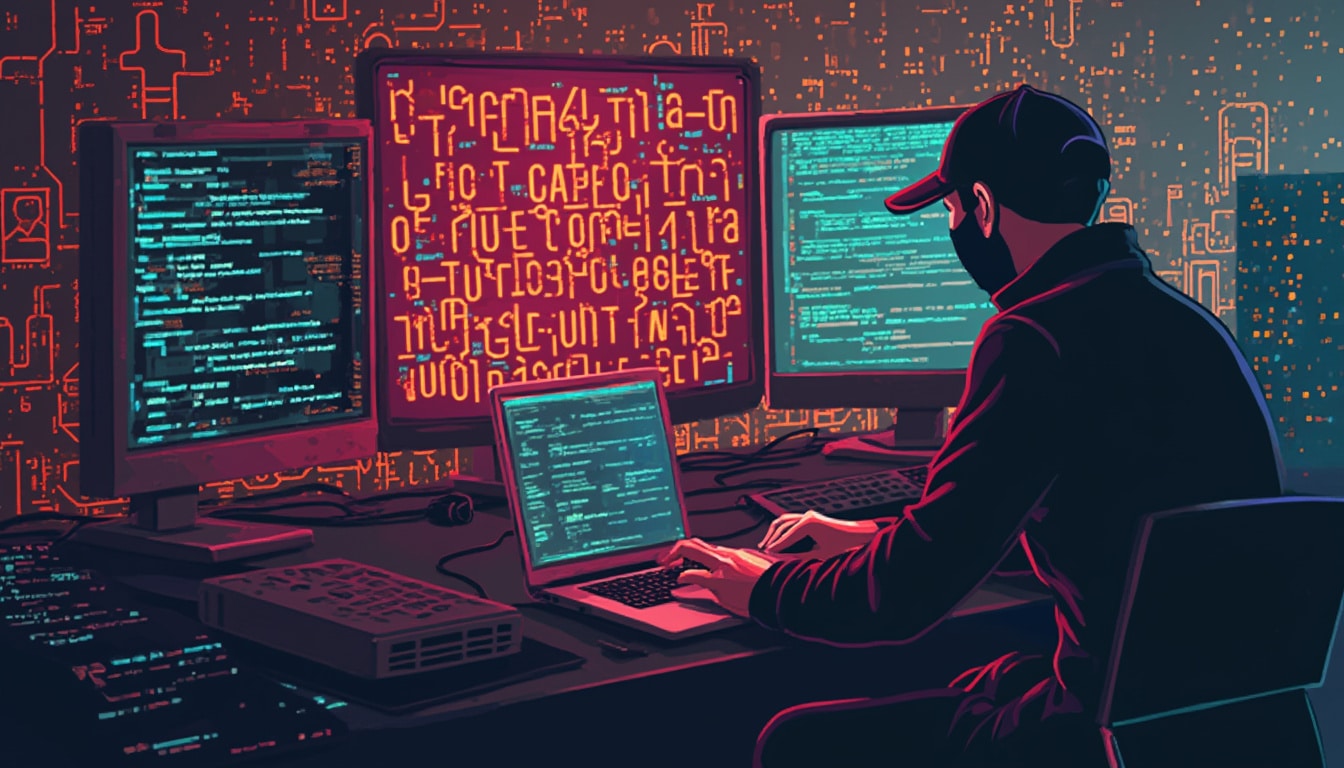« `html
The digital battlefield is expanding, and the rails are the latest frontier.Russian hackers have set their sights on Ukraine’s critical railway infrastructure.This week marks yet another episode in their relentless campaign.
These cyberattacks are not just technical nuisances; they’re strategic moves aimed at destabilizing the nation’s backbone. By exploiting system vulnerabilities, these hackers aim to disrupt services and create chaos within the rail network. Each new assault grows more sophisticated, illustrating the ever-present threat to transportation infrastructures. Behind the malicious code lies a high-stakes game that could lead to widespread disruptions.
Table of contents
ToggleThe Persistent Threat of Russian Hackers on Ukrainian Infrastructure
Once again, Ukrainian railways have become the prime target for Russian hackers, who show no hesitation in striking this vital infrastructure. This week, a large-scale cyberattack hit these rail networks, triggering a massive mobilization of security teams to safeguard sensitive data. Reports indicate that while trains continue to run, the IT system disruptions are significant.
You might also like this article:
Impact on Mobility and the Economy
The repercussions of these attacks extend beyond merely disrupting rail services. The Ukrainian economy, already strained by ongoing conflict, is taking a heavy toll from these cyber assaults. Cybersecurity experts emphasize the need to reinforce defense systems to prevent similar incidents in the future. According to BFMTV, these cyberattacks might also serve as a political warning.
You might also like this article:
Response from Cybersecurity Experts
In response to the severity of these attacks, cybersecurity specialists in Ukraine and internationally are mobilizing to counter these threats. Protecting critical infrastructures has become an absolute priority, and concrete measures are being implemented to enhance the resilience of railway IT systems. RailTech reports that despite the sophistication of these attacks, international cooperation could be crucial in this technological battle.
This week, the Ukrainian railway infrastructure found itself under siege once more as a sophisticated cyberattack was launched by Russian hackers. These relentless digital assailants have been exploiting every vulnerability they can find within the railway systems, aiming to disrupt services and create chaos within Ukraine’s critical transportation network. The persistence and increasing sophistication of these attacks underscore a persistent and escalating threat to the nation’s infrastructure.
how are russian hackers compromising ukrainian railway systems?
The latest cyberattack on Ukraine’s railways demonstrates a troubling escalation in the tactics employed by Russian hackers. These cybercriminals are meticulously identifying and exploiting security gaps within the railway’s digital infrastructure. By infiltrating the control systems, they can manipulate scheduling, disrupt communication channels, and potentially cause significant operational failures. The methods used range from deploying malicious code to conducting phishing campaigns aimed at gaining unauthorized access to sensitive data.
Moreover, the attackers are not stopping at surface-level intrusions. They are delving deep into the network protocols, seeking ways to create more profound disruptions that could lead to large-scale paralysis of the railway services. This persistent targeting highlights the critical need for robust cybersecurity measures within Ukraine’s transportation sector to safeguard against such malicious activities.
what are the immediate impacts of these cyberattacks on daily operations?
The immediate consequences of these cyberattacks are multifaceted, affecting both the functionality of the railway system and the daily lives of Ukrainian citizens. Although trains have continued to operate, the IT disruptions have led to delays, rerouting of services, and increased operational costs as the railway authorities work tirelessly to restore normalcy. These interruptions not only inconvenience passengers but also strain the logistics and supply chains that rely heavily on rail transport.
Additionally, the cyberattacks have forced the railway companies to divert resources towards incident response and system recovery efforts. This diversion of focus can impede the implementation of planned upgrades and maintenance, potentially leaving other areas vulnerable to future attacks. The sustained pressure from these cyber intrusions emphasizes the necessity for continuous investment in cyber defense strategies to maintain the integrity and reliability of vital transportation networks.
what are the broader economic consequences of these cyberattacks?
The economic ramifications of these cyberattacks extend beyond the immediate operational disruptions. Ukraine’s economy, already burdened by ongoing conflict and instability, faces additional strain as the efficiency of one of its key infrastructure sectors is compromised. The railway system is a backbone for both passenger transport and freight logistics, and any disruption can have a ripple effect, impacting various industries and commerce.
Experts in cybersecurity warn that persistent cyberattacks can deter foreign investment, as businesses may perceive the environment as increasingly unstable and risky. Furthermore, the costs associated with mitigating these attacks, upgrading security systems, and compensating for operational losses can divert funds from other critical areas such as healthcare, education, and infrastructure development. According to BFMTV, these cyberattacks could also serve as a political warning, signaling increased aggression and intentions to destabilize Ukraine further.
how are cybersecurity experts responding to these threats?
In response to the escalating cyber threats, cybersecurity experts both within Ukraine and internationally are mobilizing to reinforce the defenses of critical infrastructure. These specialists are implementing advanced security protocols, conducting regular vulnerability assessments, and fostering greater collaboration between different sectors to ensure a unified defense against the attackers. The emphasis is on creating a resilient framework that can quickly adapt to and mitigate the evolving tactics of the hackers.
International cooperation plays a pivotal role in this defense strategy. By sharing intelligence, resources, and best practices, cybersecurity teams can better anticipate and counteract the methods used by Russian hackers. RailTech reports that despite the increasing sophistication of these attacks, the combined efforts of global cybersecurity communities could prove instrumental in safeguarding Ukraine’s railways. Additionally, the integration of AI-driven security solutions is enhancing the ability to detect and respond to threats in real-time, providing an added layer of protection against potential breaches.
what long-term strategies are needed to protect critical infrastructure?
Protecting critical infrastructure like Ukraine’s railways requires a comprehensive, long-term approach that goes beyond immediate incident response. Key strategies include continuous investment in advanced cyber defense technologies, fostering a culture of cybersecurity awareness among employees, and establishing robust incident response plans that can be quickly activated in the event of an attack.
Furthermore, it is essential to collaborate with international partners to stay ahead of emerging threats and to leverage global expertise in cybersecurity. Regular training and simulation exercises can ensure that cybersecurity teams are well-prepared to handle complex attacks. Implementing redundant systems and fail-safes can also minimize the impact of any single point of failure, ensuring that critical services remain operational even under duress.
Ultimately, the protection of critical infrastructure requires a multi-layered approach that integrates technology, human expertise, and strategic partnerships. By prioritizing these elements, Ukraine can build a more resilient infrastructure capable of withstanding the persistent threat posed by Russian hackers.
how can other countries learn from Ukraine’s experience?
Ukraine’s ongoing battle against cyberattacks on its railway infrastructure serves as a valuable case study for other nations facing similar threats. One of the primary lessons is the importance of proactive cybersecurity measures. Countries must continuously assess and strengthen their own critical infrastructure to defend against potential intrusions, ensuring that vulnerabilities are identified and addressed before they can be exploited.
Another key takeaway is the necessity of international collaboration. By working together, nations can share intelligence, resources, and strategies to combat cyber threats more effectively. This collective effort can lead to the development of standardized security protocols and the establishment of rapid response teams that can assist in times of crisis. Moreover, investing in cybersecurity training and education for both public and private sector employees can enhance overall resilience and reduce the likelihood of successful attacks.
Ukraine’s experience also highlights the need for a robust legal and regulatory framework to support cybersecurity initiatives. Clear policies and regulations can provide guidelines for organizations to follow, ensuring that there is a consistent and coordinated approach to protecting critical infrastructure. By learning from Ukraine’s challenges and responses, other countries can better prepare themselves to defend against the ever-evolving landscape of cyber threats.
what role does technology play in mitigating cyber threats?
Technology plays a crucial role in mitigating cyber threats, serving as both the first line of defense and a critical tool for responding to attacks. Advanced encryption techniques can protect sensitive data from unauthorized access, while sophisticated firewall and intrusion detection systems can monitor network traffic for suspicious activity. Additionally, the use of machine learning and artificial intelligence in cybersecurity can enhance the ability to detect and respond to threats in real-time, identifying patterns that may indicate an impending attack.
Moreover, the implementation of blockchain technology can provide an immutable record of transactions and communications, making it more difficult for attackers to tamper with or manipulate data. Regular software updates and patch management are also essential in closing off vulnerabilities that hackers could exploit. By leveraging these technologies, organizations can create a more secure and resilient infrastructure that is better equipped to handle the complexities of modern cyber threats.
what can small businesses do to protect themselves from similar attacks?
While the cyberattacks on Ukraine’s railways are large-scale incidents, small businesses can also take significant steps to protect themselves from similar threats. Firstly, implementing strong password policies and using multi-factor authentication can prevent unauthorized access to sensitive systems. Regularly updating software and systems to patch vulnerabilities is another critical measure that can help safeguard against potential breaches.
Additionally, small businesses should invest in cybersecurity training for their employees, ensuring that everyone is aware of the latest threats and best practices for avoiding them. Establishing a comprehensive incident response plan can also enable businesses to quickly and effectively respond to any security breaches, minimizing the impact of an attack. For more detailed strategies, small business owners can refer to resources like this guide on safeguarding your online store.
how is artificial intelligence transforming cybersecurity defenses?
Artificial intelligence (AI) is revolutionizing the field of cybersecurity by providing advanced tools and techniques to detect and respond to threats more efficiently. AI-driven systems can analyze vast amounts of data in real-time, identifying unusual patterns and behaviors that may indicate a cyberattack. This capability allows for the early detection of potential threats, enabling organizations to take proactive measures to prevent breaches.
Furthermore, AI can automate many aspects of threat hunting and incident response, reducing the time it takes to mitigate attacks and allowing cybersecurity professionals to focus on more complex tasks. According to Accenture, the integration of AI into cybersecurity operations can significantly enhance the effectiveness of defense mechanisms, making it easier to stay ahead of increasingly sophisticated cyber threats. By leveraging AI, organizations can build more resilient and adaptive security infrastructures that are capable of evolving alongside the tactics of cybercriminals.
what emerging threats should we be aware of in the cybersecurity landscape?
The cybersecurity landscape is continually evolving, with new threats emerging as technology advances. One such emerging threat is the exploitation of Internet of Things (IoT) devices, which can serve as entry points for attackers seeking to infiltrate larger network systems. As more devices become interconnected, the attack surface expands, providing more opportunities for cybercriminals to launch attacks.
Another concerning trend is the rise of deepfake technology, which can be used to create convincing but fraudulent content, potentially leading to misinformation and undermining trust in digital communications. Additionally, the increasing use of cloud services introduces new security challenges, as ensuring the protection of data across multiple platforms requires comprehensive and dynamic security strategies.
Cyber threats are also becoming more targeted and personalized, with attackers leveraging social engineering techniques to manipulate individuals into divulging sensitive information or granting access to secure systems. Staying informed about these emerging threats and adapting security measures accordingly is essential for maintaining robust defenses in an ever-changing digital environment.
where can organizations find more information and resources on cybersecurity?
Organizations seeking to enhance their cybersecurity posture can access a wealth of information and resources to guide their efforts. Trusted sources such as Innova News offer insights into the latest vulnerabilities and protective measures that can be implemented. Additionally, specialized platforms provide comprehensive guides on protecting against data theft and other cyber threats.
Engaging with industry forums, attending cybersecurity conferences, and participating in training programs are also effective ways to stay updated on best practices and emerging trends. Collaborating with cybersecurity experts and leveraging external consulting services can provide tailored solutions that address specific organizational needs. By utilizing these resources, organizations can build a robust and adaptive cybersecurity framework that safeguards their critical infrastructure against evolving threats.
consequences on the mobility and economy
The impact of these cyberattacks extends well beyond the immediate disruption of railway services, affecting both mobility and the broader economy. As the railway system is a crucial component of Ukraine’s transportation network, any interruptions can lead to significant delays and rerouting of trains, affecting commuters and the timely delivery of goods. This not only inconveniences passengers but also hampers the efficiency of businesses that rely on rail transport for logistics and supply chain operations.
Economically, the compounded effect of disrupted services can strain the already fragile Ukrainian economy. The costs associated with repairing and securing the compromised systems divert funds from other essential sectors, such as healthcare and education. Additionally, the persistent threat of cyberattacks can deter foreign investment, as investors may perceive the environment as increasingly unstable and risky. This scenario underscores the urgent need for comprehensive cybersecurity strategies to protect vital infrastructure and ensure economic stability.
Experts emphasize the importance of bolstering the resilience of economic systems against cyber threats. By investing in advanced security measures and fostering international cooperation, Ukraine can better safeguard its economic interests and maintain the uninterrupted flow of goods and services crucial for economic growth and stability.
la riposte des experts en cybersécurité
Face à l’ampleur des attaques, les spécialistes de la cybersécurité en Ukraine et à l’international se mobilisent pour contrer ces menaces. La protection des infrastructures critiques, telles que les chemins de fer, est devenue une priorité absolue. Des mesures concrètes sont mises en place pour améliorer la résilience informatique des systèmes ferroviaires, notamment par l’adoption de technologies avancées de détection et de réponse aux incidents.
RailTech rapporte que malgré la sophistication croissante de ces attaques, la coopération internationale pourrait s’avérer déterminante dans cette lutte technologique. Les experts collaborent avec des partenaires mondiaux pour partager des informations sur les menaces émergentes et développer des stratégies de défense communes. Cette approche collaborative permet de renforcer les défenses, de mieux anticiper les tactiques des hackers et de réagir de manière plus efficace face aux incidents de sécurité.
En outre, l’intégration de l’intelligence artificielle dans les systèmes de cybersécurité offre de nouvelles possibilités pour détecter et neutraliser les attaques avant qu’elles ne causent des dommages significatifs. L’utilisation de l’IA permet une analyse plus rapide et plus précise des données de sécurité, facilitant ainsi une réponse proactive aux menaces potentielles.
les enjeux de la protection des données et des infrastructures
Derrière les lignes de codes malveillants, les enjeux de ces cyberattaques sont énormes. Les systèmes vulnérables deviennent des proies faciles, ouvrant la voie à de potentielles perturbations à grande échelle. La protection des données sensibles et la sauvegarde des infrastructures critiques sont désormais au cœur des priorités nationales. Les défis incluent non seulement la prévention des attaques, mais aussi la capacité à réagir rapidement et efficacement lorsqu’une intrusion se produit.
Les Ukrainiens, déjà durement éprouvés par des tensions continues, font face à ce défi sans précédent. Les efforts pour sécuriser les infrastructures nécessitent une approche holistique, intégrant la technologie, les ressources humaines et les politiques publiques. En renforçant les capacités de cybersécurité et en investissant dans des solutions innovantes, le pays peut mieux se protéger contre les menaces actuelles et futures.
La sensibilisation et la formation des équipes de sécurité sont également cruciales pour anticiper et contrer les techniques sophistiquées employées par les hackers. En outre, la mise en place de protocoles de sécurité rigoureux et la réalisation d’audits réguliers contribuent à identifier et à combler les vulnérabilités avant qu’elles ne soient exploitées.
Enfin, l’importance cruciale d’une cybersécurité renforcée ne peut être sous-estimée. Elle est essentielle pour maintenir la confiance dans les systèmes de transport et assurer la continuité des opérations vitales pour la société. Les experts en cyber défense jouent un rôle déterminant dans cette lutte, travaillant sans relâche pour enrayer les escalades numériques et protéger les infrastructures stratégiques contre les attaques incessantes.
la sécurité des infrastructures stratégiques au cœur de la bataille virtuelle
Cet affrontement silencieux, à l’ombre des coulisses, rappelle à quel point la sécurité des infrastructures stratégiques est devenue une bataille engagée sur le front virtuel. Les attaques contre les chemins de fer ukrainiens ne sont qu’un exemple parmi tant d’autres de la guerre numérique qui se joue actuellement. Chaque attaque réussie représente non seulement une menace immédiate pour les services publics, mais également une érosion de la confiance dans les capacités du pays à protéger ses atouts essentiels.
La défense des infrastructures stratégiques demande une vigilance constante et une adaptation continue aux nouvelles méthodes des cybercriminels. Cela inclut l’adoption de technologies de pointe, la formation continue des professionnels de la sécurité et la mise en place de partenariats stratégiques avec des entités internationales spécialisées dans la lutte contre la cybercriminalité.
En fin de compte, la résilience des infrastructures critiques repose sur une combinaison de technologie avancée, de politiques de sécurité robustes et d’une coopération étroite entre les différents acteurs du secteur. En investissant dans ces domaines et en encourageant une culture de cybersécurité proactive, l’Ukraine peut espérer renforcer sa défense contre les cyberattaques et assurer la stabilité et la continuité de ses services publics indispensables.
Pour personnaliser davantage votre approche et découvrir des stratégies efficaces de protection, explorez des ressources spécialisées telles que cet article sur les nouvelles techniques de hacking ou ce rapport sur les vulnérabilités des TPU.














